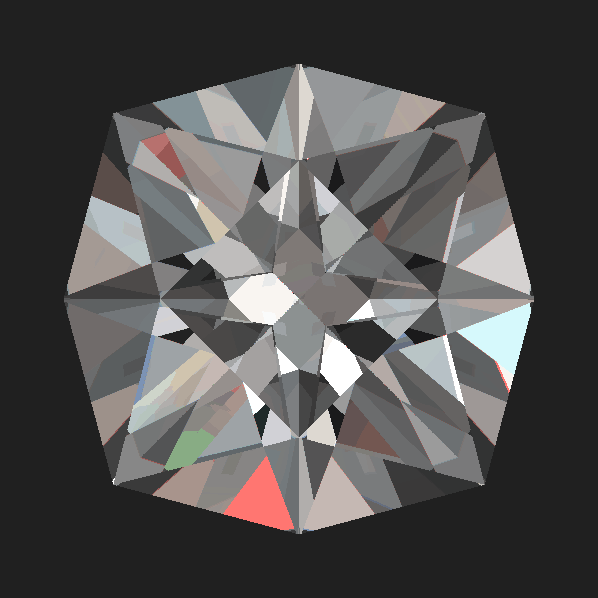For as long as I can remember I have been fascinated by rocks, minerals and fossils and in 1967 at the age of 13, using very basic equipment, I started cutting cabochons. I also had a go at cutting faceted stones. For this all I had was a simple cabbing machine with a (far from) flat lap, a dop to which was attached an octagonal guide creating a so called template faceter, a stack of plywood squares for adjusting the height of the guide and a school protractor for guesstimating angles. Having produced, by guesswork, a first stone in colourless quartz I really wanted a faceting machine. Sadly even the most inexpensive machine available at the time was entirely beyond my means. It was some 50 years until I was able to fulfill my dream with both the time to facet and the means to acquire the best machine for the job, the Ultra Tec V5.

My first "faceted gemstone".
A bit battered now having spent a lifetime in my wife’s purse and 'treasure box' as a keepsake.
Nothing at all to be proud of in all ways imaginable to a 'proper' faceter but.... aged 13 and with minimal equipment it sparked an interest that only now have I been able to embrace.
At the time my ambition was to cut stones of the type seen and generally admired in all jewellery stores, the Standard Round Brilliant. When I eventually acquired my Ultra Tec this was still my ambition (now I wonder why) and this was the first design I chose to cut - poor choice! The SRB is a straightforward design with 8-fold mirror-image symmetry but it has a large number of facets, 73 including girdle facets. It also has a similarly high number of meet points to make including 8 between the table and star facets. A reasonable challenge for an experienced faceter never mind one attempting their first stone. Needless to say, I made errors with my first stone but I was delighted with it. However, with the benefit of hindsight, a very much simpler design would have produced an equally pleasing result and provided a much better learning platform. Furthermore, the stone could be of a type that you will never encounter commercially. While the SRB is a very effective design it is produced in millions every year. There is nothing unique about the SRB and as I cut many stones to produce gifts for family and friends I like my gifts to be just that, unique. This is where private cutting and gemstone design come into their own and even low cost synthetic materials like cubic zirconia, spinel and corundum acquire commercial value when well cut to unique designs.
In chapter 5 of his book Amateur Gemstone Faceting (volume 1), Tom Herbst provides an in-depth account and his personal opinions on cutting your first gemstone. Experienced faceters may not agree with all he has to say and use different techniques for some elements of the faceting process but there is no doubt that he provides priceless advice, especially to those without a mentor, and a very effective, simple, first stone design, GeM101. I wish I had started with this! I have recently cut it in CZ and quartz and can confirm that it is both easy and fun to cut. It works well in both materials and the resulting gems are bright with lots of sparkle. A great way to start!


GeM101 in (left) citrine and (right) pale blue CZ
GeM101 is hexagonal in outline, has a small number of facets, 31 in all compared with the SRB’s 73, a correspondingly low number of meet points to make and, best of all for the beginner, no table facet meets to make. All in all an excellent choice for a first stone and one that lets you practice all the skills required to produce gems of more complex design. Very many of these will involve table meets so here is my simple design to give a first taste of these. Despite its octagonal outline it only has 2 more facets than GeM101 and like this it has crown and pavilion main facets unaligned with each other (unstacked) to produce lots of sparkle. If cut carefully the table meets should come together well but inevitably one or two of the main facets may have to be revisited in order to polish in the meets. There are various ways of approaching this but keeping a log in which are recorded data, including cheater settings, for each facet permits a rapid way of establishing the starting point for fine adjustments. For another simple crown also have a go at my Hex Triangles design, originally produced for a small piece of Iolite I had.
Have Fun!

Gem2 cutting diagram and a face up rendition from GemRay in colourless CZ.
Below the real deal in blue CZ and an animated rendition in colourless CZ created in Gem Cut Studio.
For more easy-to-cut designs based on Gem2 have a look at the News page.





